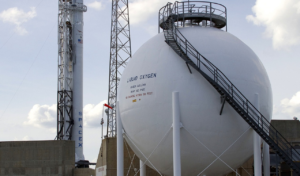Rocket fuels are the propellant compounds that rockets use to generate propulsion, allowing them to escape Earth’s gravity and fly across space. The propellant is a chemical mixture composed of fuel and an oxidizer that is burned to provide thrust in rockets.
Fuel is a material that burns when coupled with an oxidizer to power a vehicle.
Rocket fuels are divided into three categories:
- Liquid rocket fuels
- Solid rocket fuels
- Hybrid rocket fuels
Liquid Propellants

In a liquid propellant rocket, the fuel and oxidizer are stored in separate tanks and delivered to a combustion chamber by a system of pipes, valves, and turbopumps, where they are combined and burned to produce thrust.
Advantages: The engine can be throttled, halted, or restarted by managing the flow of propellant to the combustion chamber.
Disadvantage: Storable oxidizers such as nitric acid and nitrogen tetroxide are exceedingly poisonous and highly reactive, although cryogenic propellants can also have reactivity/toxicity difficulties when stored at low temperatures.
There are three types of liquid propellants utilized in rocketry: petroleum, cryogens, and hypergolic.
Petroleum fuels are processed from crude oil and are a complex mixture of hydrocarbons, which are organic substances that solely contain carbon and hydrogen. The petroleum used as rocket fuel is a refined form of kerosene.
Cryogenic propellants are liquefied gases held at extremely low temperatures, with liquid hydrogen (LH2) serving as the fuel and liquid oxygen (LO2 or LOX) serving as the oxidizer. At temperatures of -253 oC (-423 oF), hydrogen remains liquid, while oxygen remains liquid at temperatures of -183 oC (-297 oF).
Hypergolic propellants and oxidizers spontaneously ignite on contact and do not require an ignition source. Hypergolic are useful for spaceship maneuvering systems due to their ease of starting and restarting.
Since they remain liquid at normal temperatures, hypergolic propellants do not face the same storage issues as cryogenic propellants. However, they are extremely poisonous and require extreme caution when handling. Examples of hypergolic propellants include hydrazine, monomethylhydrazine (MMH), and unsymmetrical dimethylhydrazine (UDMH).
Solid propellant rockets represent the most basic of all rocket designs. They consist of a casing, usually made of steel, filled with a mixture of solid compounds (fuel and oxidizer) that burn quickly, expelling hot gases through a nozzle to produce thrust. When ignited, a solid propellant burns from the center outward toward the casing’s sides.
Solid propellants

They are classified into two types: homogeneous and composite. Both are thick, stable at room temperature and easily stored.UDMH) are examples of hypergolic fuels.
Composites: They are generally made up of granules of solid oxidizers such as ammonium nitrate, ammonium dinitramide, ammonium perchlorate, or potassium nitrate mixed with a polymer binding agent.
Single-, double-, or triple-bases are homogenous combinations of one to three primary ingredients (depending on the number of primary constituents).
Advantages: Unlike liquid propellant rockets, solid propellant rockets are much easier to store and handle. The high propellant density also results in a small size.
Disadvantage: Solid propellant engines, unlike liquid-propellant engines, cannot be turned off. When ignited, they will burn until the propellant is depleted.
Hybrid propellant engines
These engines fall somewhere between solid and liquid propellant engines. One of the components is solid, usually, the fuel, while the other is liquid, usually the oxidizer. The liquid is injected into the solid, which also functions as a fuel reservoir and a combustion chamber.
The fundamental benefit of such engines is that they have great performance, comparable to solid propellant engines, but the combustion may be slowed, stopped, or even restarted. Since it is difficult to apply this concept to very big thrusts, hybrid propellant engines are rarely produced.






















































